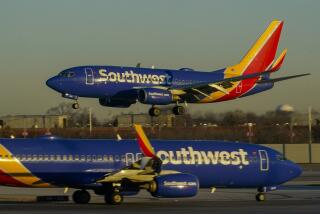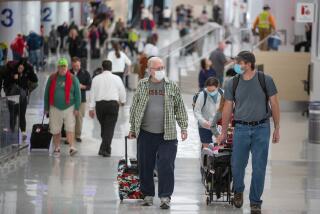Staff Illnesses Force Flight Cancellations
- Share via
The otherwise efficient operations at Southwest Airlines were thrown into chaos Christmas Eve by the tiniest of gremlins--a virus.
Airline officials said an outbreak of the flu grounded flight attendants in four states this week, forcing the cancellation of 50 flights Wednesday and 100 flights Tuesday, leaving thousands of travelers temporarily stranded in airports from Los Angeles to Baltimore.
The Southwest woes added a new dimension to the usual pre-Christmas traffic headaches at area airports. Officials at Los Angeles International and Burbank airports said the facilities were busy with the usual holiday congestion, although other carriers were not experiencing any major delays.
At the Southwest gates at Burbank Airport on Wednesday, hundreds of passengers milled about, some of whom were still waitingsix hours after their scheduled departure.
“We could be [in Sacramento] right now if we were driving,” said Rebecca Roe, 25, of Woodland Hills. “But my money is tied up in a $200 ticket.”
*
Word soon spread among the frustrated passengers that the cancellations were part of an intentional sickout by flight attendants, a rumor quickly denied by officials at Southwest and the flight attendants’ union.
The real explanation, according to Southwest spokesman Ed Stewart: “Sick folks.”
“Unfortunately, the cold and the flu has gotten the better of them,” he said.
Shea Spencer, an officer of Transport Workers Union’s Local 556 in Dallas, also blamed the absences on the flu. She said there was “absolutely not” an organized sickout and that labor relations between the company and the union, which represents 4,400 flight attendants, are “very good.”
In all, about 90 flight attendants called in sick Wednesday, nearly four times the daily average. Some workers showed up for the flights, but were sent home, officials of the Dallas-based airline said.
By all accounts, it was an odd day at the no-frills air carrier, which routinely ranks first among airlines for on-time arrivals and departures.
At LAX, Flight 1194 was scheduled to leave at 9:05 a.m. for Las Vegas, Omaha and Chicago. By noon, a hundred or so passengers were still hunched in their seats or sitting on the carpeted floor outside Gate 3.
“I hope the crew isn’t as sick as I am,” said Beau Allen, a 65-year-old cancer patient headed for Las Vegas. Allen made a desperate and futile plea to a Southwest Airlines representative to get him on a flight with another airline.
“I just want to get home,” he said. “I want to get on another flight, but nobody wants to hear me.”
Another disappointed Vegas-bound passenger was Gino Rindone, who had a rare three days off from the Italian restaurant he manages in Beverly Hills.
“People are very frustrated,” Rindone said, adding that he had not been told with any degree of certainty when he might be able to leave Los Angeles. “I have this vacation. I want to relax. The silly thing is they [Southwest] don’t have any answers. They have said nothing. Zero.”
*
For passengers, there was irony in the fact that the cancellations came on a day when the weather was unusually good, even in many cold weather destinations. But compared with the enormous disruption the cancellations would have had on the big transcontinental airlines, the impact on Southwest’s passengers was less because Southwest specializes in frequent, short-distance flights.
That means most of the canceled flights had a duplicate flight departing a short time later, Southwest’s Stewart said. But he conceded that because Wednesday was such a heavy travel day, there were still delays as passengers from the canceled flights tried to squeeze onto crowded airplanes.
Southwest is known for sporting a sense of humor, but there were few smiles Wednesday at its Southern California terminals, especially among those workers whose vacations were suddenly cut short when they were summoned to fill in for their sick colleagues.
“I left three kids at home,” said one flight attendant. “We have no idea why they called us.”
Although many people believe that the recirculating air on planes makes the aircraft incubators for airborne diseases, most researchers believe that infections are spread on planes by the proximity of the carrier and victims.
Influenza and measles viruses are the most likely to be transmitted on a crowded aircraft, according to Dr. Richard P. Wenzel of the Medical College of Virginia. When passengers cough, the viruses are expelled in tiny droplets that can linger in the cabin air for hours. Such droplets are easily breathed into small passageways in the lungs.
Whatever the cause, the canceled Southwest flights put a crimp in the Christmas plans of many a traveler.
“Southwest is still number one, but they should have decked the halls with holly instead of people,” said Yvonne Bacy-Bujer of Pasadena, one of a group of stranded passengers at Burbank Airport.
*
Times staff writers James F. Peltz and Thomas H. Maugh II and correspondent Deborah Belgum contributed to this story.
More to Read
Inside the business of entertainment
The Wide Shot brings you news, analysis and insights on everything from streaming wars to production — and what it all means for the future.
You may occasionally receive promotional content from the Los Angeles Times.











